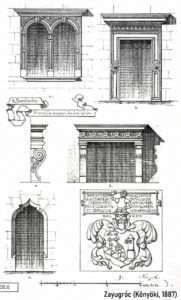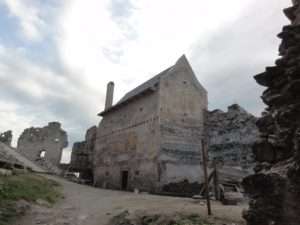Zayugróc
Zayugróc (Uhrovec) is a village in the Trencsén (Trenčín) district in the Bán region of Slovakia, famous for its castle built in the 1250s in the Kingdom of Hungary.

In the 1250s and 1260s, Comes Bás of the Mezőpilis clan acquired his lands in Trencsén County and built the castle of Ugróc, first mentioned in 1293. According to the document, King András III investigated the complaint of Bás’s son Péter that the son of the late Palatine [Csák] Péter called [Csák Máté] had caused damage amounting to 100 marks to the Ugróc castle and the associated estates and serfs, as well as to the Mikola estate near the Garam River. The construction of the early castle can be divided into two periods: the present inner castle, roughly triangular, with towers at its corners, and the Romanesque castle chapel, reminiscent of small village churches, built after 1260.

According to the testimony of the Chapter of Nyitra, in 1295 Csák Máté, the chief stable master, acquired the Ugróc castle (“Castrum suum Vgrog vocatum”) from Bás’s son Péter using an exchange of estates. The Ugróc estate consisted of the castle, the villages of Podluzsán, Baan, Nezche, Ugróc, Banczuch, Szitnya, Radosnya, and Sonko, for which Csák Máté gave the villages of Tolmács, Bars, Mohi and Poth for another 50 marks.

On 19 June 1297, Mikolai Miklós, the son of Count Péter, protested against this exchange, claiming that he and his father Maté had been persuaded to make the deal by death threats and intimidation that could shake even a strong man. In 1299, the Chapter of Esztergom proved that the exchange had taken place, and Master Péter and his son Miklós sold Ugróc (“Castrum suum Vgroyg”) to Csák Máté. Csák, the lord of Trencsén, wanted to create a coherent territory, so he bought the castle of Ugróc, which was situated between Trencsén and Tapolcsány.

After the death of Csák Máté in 1321, in March King Károly Róbert sent Gutkeled Miklós, lord of Sopron and castellan of Komárom, against the estates of the lord of Trencsén. Miklós took the castles of Appony, Privigye, Bajmóc and Ugróc in turn. Ugróc became a royal castle. In 1329 Miklós’s son Gál magister, royal special notary, was the castellan of Ugróc (“Wgrogh”).

On 9 August 1344, at the request of Mikolai András, the Esztergom Chapter rewrote Mikolai Péter’s protest of 1297 against the forced exchange of Csák Máté. He probably needed this because he had tried to regain the castle – without success.

In 1389, King Zsigmond donated the castle of Ugróc to his favorite warlord and follower, Stiborici Stibor of Polish origin, and his brothers. In 1399, for unknown reasons, Jolsvai György gave the village of Bazna, which belonged to Ugróc Castle, to Holc’s son Péter for settlement.

In 1410 it was again in the possession of Stibor, who took possession of Szebedás and attached it to the castle. In 1434, after the death of Stibor the Younger, the castle returned to the king, who gave it to his wife, Queen Cillei Borbála. In 1439, after the death of Zsigmond, his successor and the husband of her daughter, King Albert Habsburg, took it from his mother-in-law, who had plotted against him, and gave it to his wife, Erzsébet of Luxembourg.

According to a document from 1439, the castellan of Ugróc was Sellendorf “dictus” Konrad of Wychap. Between 1440 and 1467 the castle was pledged to Pongrác of Szentmiklós. On 25th September 1453, King László V irrevocably granted Pongrác Berencs, Ugróc, Újvár, and Lykava, as well as the seat of Nagyvár in Liptó with all its debts, as a reward for his services, and gave Strecsény, Óvár and the right to collect the thirty-quarter tax of Zsolna in exchange for eighteen thousand gold forints.

In 1454, according to the Pongrácz family agreement, the estate was given to Szentmiklósi Pongrác’s younger brother, Ugróc János, who was introduced to the estate in 1455. During the Pongrácz family’s tenure, a three-story Gothic palace was built in the northeastern part of today’s inner castle.

In 1477, for unknown reasons, King Matthias took the castle from the heirs of Pongrácz János, who protested against it. From then on, the history of the castle’s ownership is confused. According to some authors, King Matthias pledged the castle to his mercenary leader, William Tettauer, and according to others, to a knight of his court, Friedrich Tettauer.

The Tettauer family owned the castle until 1483. However, according to documents, Pongrácz János mortgaged the castle to his wife, Soky Borbála, in 1481, because the money Borbála had brought from her first husband, Nádasi Simon, was deposited in Ugróc. In 1481, Borbála and her daughters were granted a pledge of the Ugróc castle and its outbuildings. In 1483 the castle was definitely in the hands of the Tettauer family.

In 1483, Dobozi Dánffy András and Márton pledged the castle from Tettauer for 7000 forints. In 1485 Latkóczy /Latkovszky Péter was the warden of Ugróc castle. According to some records, in 1483 Vicsapi András was also a part owner of the castle.

In 1506, Ugródi Kollár Borbála, the widow of Dobozi Dánffy András, according to the charter of the Garamszentbenedek monastery, gave the castrum suum Wgrocz with its accessories to Salzer / Zabláthy Lőrinc for 7000 forints, and to his wife Márta and his sons György, János, Jeromos, Márton and Mátyás on the condition that the manor and its income belong to the widow for the rest of her life.

In a charter of 1517, it was mentioned as “castrum Wgrogh”. In 1520 the Zabláthy family received the Ugróc estate (Dánffy’s widow died). In 1525 Lőrinc Zabláthy divided his property among his children, and the Ugróc castle and the manor house were given to György and Jeromos (“Wgrocz castellulum sive fortalitium”).

In the tax census of 1533, it was mentioned as “castri Vgrod”. It was in the hands of Szilágyi Péter until 1546. It was under his ownership that the outer castle was built. At that time counterfeit money was minted in the castle.
In 1547, King Ferdinand I donated the Ugróc Castle and its possessions to Zay Ferenc. He and his sons carried out the Renaissance reconstruction of the castle until 1589. The castle did not play an important military role but served as a refuge for the nobility and the local population. According to an inventory of 1572, the castle had 24 cannons with 32 hundredweight of gunpowder.

During the Rákóczi War of Independence, Zay Lőrinc became Rákóczi’s advisor. According to a letter of the Kuruc general Andrássy Pál to Bercsényi, the Kuruc infantry was camped under Zayugróc Castle on 9 December 1707. In September 1708 the traitor Ocskay wanted to take Zayugróc by trickery. He wrote a letter to Zay Lőrinc, asking him to let his soldiers into the castle to get the broadcloth for making uniforms that were stored there.

After the Kuruc troops were driven out of Trencsén County, Zay Lőrinc also returned to the imperial side. In the early 18th century the lower castle burnt down, but the upper castle was still in use. In 1802 a great storm damaged the roof, which was repaired. At the beginning of the 19th century, the Zay family kept their armory here and lived here only during their hunting trips.

In 1848 the castle was attacked, looted, and burnt by anti-Hungarian Slovak rebels. It was never rebuilt. Archaeological research and conservation of the castle is still ongoing (2023).

You can visit the page of the volunteers who are renovating the castle:
https://www.facebook.com/hraduhrovec
Source: Várlexikon https://varlexikon.hu/zayugroc-var
Dear Readers, I can only make this content available through small donations or by selling my books or T-shirts:
Please, feel free to support me with a coffee here:
You can check out my books on Amazon or Draft2Digital, they are available in hardcover, paperback, or ebook:
https://www.amazon.com/dp/198020490X or at https://books2read.com/b/boYd81

My work can also be followed and supported on Patreon: Become a Patron!http://Become a Patron!
[wpedon id=”9140″]

https://hungarianottomanwars.myspreadshop.com/all








































































